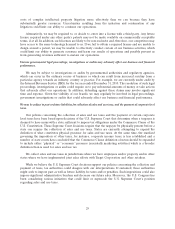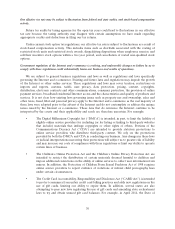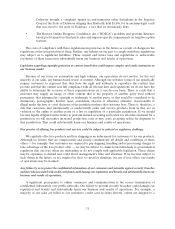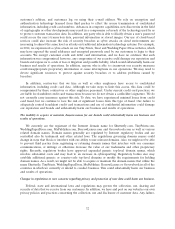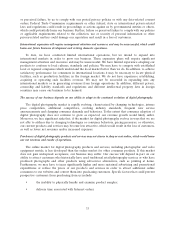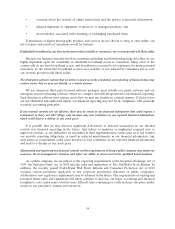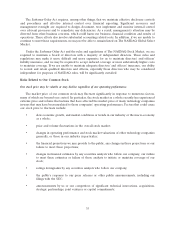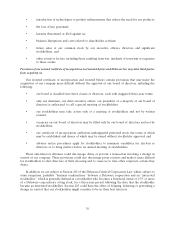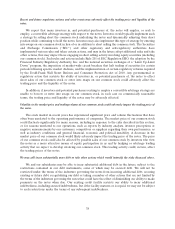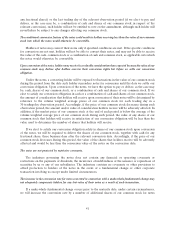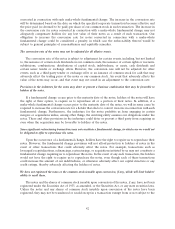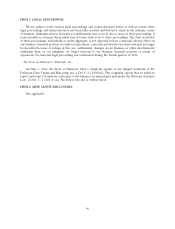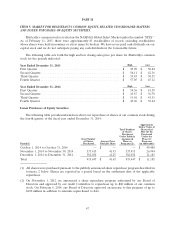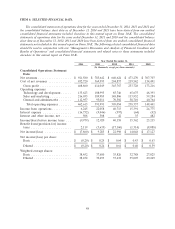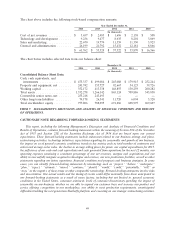Shutterfly 2014 Annual Report Download - page 40
Download and view the complete annual report
Please find page 40 of the 2014 Shutterfly annual report below. You can navigate through the pages in the report by either clicking on the pages listed below, or by using the keyword search tool below to find specific information within the annual report.We may not have the ability to raise the funds necessary to settle conversions of our notes in cash or to repurchase the
notes upon a fundamental change, and our current debt contains, and our future debt may contain, limitations on
our ability to pay cash on conversion or repurchase the notes.
Holders of the notes have the right to require us to repurchase their notes upon the occurrence of a
fundamental change at a repurchase price equal to 100% of their principal amount, plus accrued and
unpaid interest, if any. In addition, upon conversion of the notes, unless we elect to deliver solely shares of
our common stock to settle such conversion (other than paying cash in lieu of delivering any fractional
share), we will be required to make cash payments in respect of the notes being converted. However, we
may not have enough available cash or be able to obtain financing at the time we are required to make
repurchases of notes surrendered therefor or notes being converted.
In addition, our ability to repurchase the notes and settle conversions in cash is limited by our credit
facility and may be limited by law, by regulatory authority or by agreements governing our future
indebtedness. Our failure to repurchase notes at a time when the repurchase is required by the indenture
would constitute a default under the indenture. A default under the indenture or the fundamental change
itself could also lead to a default under the credit facility agreements governing our future indebtedness.
Moreover, the occurrence of a fundamental change under the indenture would constitute an event of
default under our credit facility. If the payment of the related indebtedness were to be accelerated after
any applicable notice or grace periods, we may not have sufficient funds to repay the indebtedness and
repurchase the notes or to pay cash upon conversion of the notes.
The conditional conversion feature of the notes, if triggered, may adversely affect our financial condition and
operating results.
In the event the conditional conversion feature of the notes is triggered, holders of notes will be
entitled to convert the notes at any time during specified periods at their option. If one or more holders
elect to convert their notes, unless we elect to satisfy our conversion obligation by delivering solely shares
of our common stock (other than paying cash in lieu of delivering any fractional share), we would be
required to settle a portion or all of our conversion obligation in cash, which could adversely affect our
liquidity. In addition, even if holders do not elect to convert their notes, we could be required under
applicable accounting rules to reclassify all or a portion of the outstanding principal of the notes as a
current rather than long-term liability, which would result in a material reduction of our net working
capital.
The accounting method for convertible debt securities that may be settled in cash, such as the notes, could have a
material effect on our reported financial results.
In May 2008, the Financial Accounting Standards Board, which we refer to as FASB, issued FASB
Staff Position No. APB 14-1, Accounting for Convertible Debt Instruments That May Be Settled in Cash
Upon Conversion (Including Partial Cash Settlement), which has subsequently been codified as
Accounting Standards Codification 470-20, Debt with Conversion and Other Options, which we refer to as
ASC 470-20. Under ASC 470-20, an entity must separately account for the liability and equity components
of the convertible debt instruments (such as the notes) that may be settled entirely or partially in cash upon
conversion in a manner that reflects the issuer’s economic interest cost. The effect of ASC 470-20 on the
accounting for the notes is that the equity component is required to be included in the additional paid-in
capital section of stockholders’ equity on our consolidated balance sheet and the value of the equity
component would be treated as original issue discount for purposes of accounting for the debt component
of the notes. As a result, we will be required to record a greater amount of non-cash interest expense in
current periods presented as a result of the amortization of the discounted carrying value of the notes to
39


